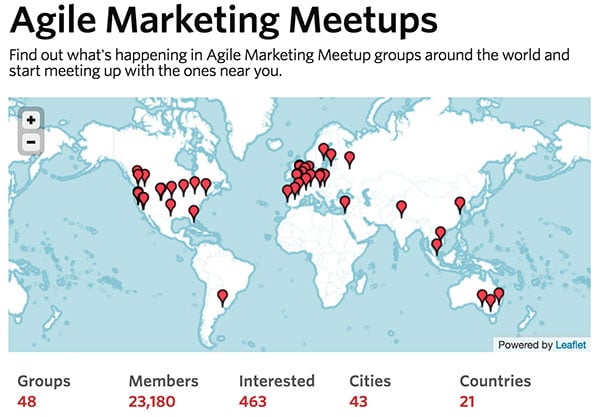 Perhaps you love Agile Marketing and are convinced it can make a difference in your organization. But your co-workers or your boss or your team if you’re the boss are skeptical. How do you convince them that Agile Marketing is worth doing? Here are four reasons for adopting Agile Marketing.
Perhaps you love Agile Marketing and are convinced it can make a difference in your organization. But your co-workers or your boss or your team if you’re the boss are skeptical. How do you convince them that Agile Marketing is worth doing? Here are four reasons for adopting Agile Marketing.
Momentum (AKA Your Competitors Are Doing Agile Marketing)
When I first got involved with Agile Marketing in 2011, there were relatively few people who had even thought about the idea, much less practiced it. Today, many people are practicing Agile Marketing. Here is some evidence that Agile Marketing has momentum, and that your competitors are very likely practicing Agile Marketing:
Google trends is one of my favorite tools. It allows you to see the popularity of a term in the news headlines over time. Here’s the chart for the term Agile Marketing:
No idea why their isn’t any data for about six months in 2012, but otherwise, you can see that the trend is solidly up over time.
Here’s another data point for you:
As you can see, there are now 48 Agile Marketing meetups around the world with over 23 thousand members. Earlier this year, I attended a meeting of the San Francisco Agile Marketing meetup. They have over 3200 members, and over 400 people attended the latest meeting. These are solid numbers.
Increased Productivity
One of the promises of Agile Marketing is that you’ll be able to get more done. This isn’t an idle promise. In one case study, the marketing group for the satellite campuses of Northern Arizona University were able to get a 400% increase in productivity. In addition, they were able to trim their budget by 20% and saw a 30% increase in the department’s client satisfaction rating.
Here’s another example: the creative team at Workfront, a SAAS Project Management company out of Levi, Utah, was able to increase its average number of tasks completed by 55% per week using Agile Marketing. The average number of tasks completed by the creative services design team per week in the year prior to adopting Agile Marketing was 17.5. Now that same team averages 27.1 completed tasks per week.
Teradata adopted Agile Marketing and as a result they felt like they doubled their productivity. As their CMO, Lisa Arthur said, “Adopting a way more Agile approach, we probably pulled off in 5-1⁄2 to 6 months what most organizations would do in 12”.
Improved Communication
Agile Marketing improves communication in organizations by establishing a discipline for prioritizing the most important and the most strategic work and by communicating to other areas of the company marketing’s activities and their results.
Particularly when they’re getting started, I encourage Agile Marketing teams to invite senior management and sales to the Sprint Planning sessions. I do this because I want marketing to get candid feedback from these other areas of the company in regards to what they need from marketing. One of the questions I developed over the years to spur discussion is as follows:
What would it take for you to say, marketing is my secret weapon?
The discipline of Agile Marketing also avoids what the developers refer to as scope creep. So many times in marketing, someone from management or sales will come in with an “urgent” request – I need this by tomorrow, it will only take you a minute.
With Agile Marketing, the answer goes like this: thanks, we’ll add that to the backlog for prioritization in the next Sprint. Usually, that should be sufficient. But if it isn’t, then the answer is, OK, we’ll do it, but what do you want to remove from the current Sprint we’re working on? This probably won’t completely eliminate the fire drill items (after all, we’re trying to stay agile, which also means being responsive), but it will encourage the conversation of how important is this item compared to all the other items on the plate.
In the same case study mentioned above, at WorkFront, the average hours spent by the team on planned work items (not including ad hoc and fire-drill items) per week increased 72%, from 55.1 hours per week to 94.9 hours per week. This allowed them to apply greater focus to strategic and planned work.
I spoke to David Lasué, who runs that team, and he mentioned that one of the unexpected benefits of Agile Marketing has been a reduced turnover rate among his staff. They were happier and experienced less burnout due to random requests. They work on a weekly Sprint cycle, and they have a very predictable rhythm to their weeks. They’re getting more done with less stress.
Agile Marketing can also communicate to other areas of the company marketing’s activities and their results. When I first started teaching Agile Marketing, I encouraged teams to use a whiteboard, rather than electronic tools, at least for their early Sprints. I did this because the rest of the company would see the Sprint board, and would see both the items that Marketing was working on, and they’d see items move from the To Be Done to the Done column.
The White board was also useful whenever discussions would come up about ad hoc or fire drill items. The team lead would walk the requestor over to the white board, and discuss where this new item fit in the prioritization, and what could be delayed or dropped to fit this new request into the queue.
I now encourage teams to use a large display screen, posted somewhere where it is visible to other teams, that shows the current sprint backlog and a few critical statistics. This allows the team to use an electronic tool for tracking the Sprint, which is increasingly important in this era of distributed teams.
Better Business Results
Agile Marketing can also lead to improved business results. Jascha Kaykas-Wolff, one of the early practitioners of Agile Marketing and the host for SprintZero, had this to say about implementing Agile at MindJet:
On one project, we have almost a 3000x lift in performance and drove a 30-percent increase in trials quarter-to quarter, just purely because of this [agile] process. And we’ve done nothing else that was different other than use these processes on this one particular campaign.
One of my favorite examples of improved business results due to an agile practice known as high tempo testing comes from Satya Patel of Twitter via a talk given by Sean Ellis at the San Francisco Agile Marketing meetup. Satya was able to roughly double his compound quarterly growth rate simply by increasing the number of tests that they ran from roughly one every other week to ten tests per week.
Xerox has been practicing Agile Marketing since 2009. For them, the most clear improvement in business results has been in their ability to prioritize and get the right things done. As Judith Frey, their VP of Interactive Marketing, said: “Because of the volume of projects that come up in the Web environment, you’re changing things on an ongoing basis. A way to manage those and prioritize them so you’re always working on the highest value projects is very much congruent with how agile operates.”
So what do you think? How do you convince the skeptics?






Hello Jim,
Great post! One way may to nudge the skeptics is to appeal to our need to actually finish something instead of working on a project interminably where it never quite gets finished.
Here is a post I wrote on Linked In last week on this topic.
++++++++++++++++++++++++++
Done is better than perfect.
This has been one of my guiding parameters at work and elsewhere for years. I am imperfect-able. This is not a statement of weakness but rather humility and honesty (both of which are virtues to be cultivated even though they are extremely counter-cultural). This is also not an endorsement of pushing something of low quality out the door simply to meet a deadline. I, and maybe you do too, have a tendency to do good work, then second-guess myself and spend more time nibbling on the edges to try to improve what was already acceptable for a customer. A similar scenario is when good work has been done by a team only to be reviewed and approved by too many others causing delays, re-dos which result in loss of momentum, market share, etc. In each case, even though you have put a lot of effort into it, the actual work or project never seems to get “done”. This saps my passion when I don’t get to check something off my list, when I don’t get to know that the customer I worked for actually is using what I toiled over. I have been blessed to begin working this year in an Agile environment where we take big projects and break then down into small digestible and deliverable chunks of finished work every two weeks. We can’t do everything (no one can) but we focus on what we CAN DO. The team members, all of us get to enjoy, on a regular two-week cadence, the satisfaction of knowing our customers are getting a steady stream of value from our efforts. In this sense, “done” feels pretty good.
Great article Jim! Development learned that they needed strong executive support to successfully implement Agile. Marketing execs are no diffrent than Dev execs, they thirst for more predictability and visibility. I think the key to convincing sceptical marketing executives is to show them how Agile will provide them more visibility into the progress of work and how that will lead to more predictable production of marketing work and results.
Hi Jim,
I think you are right on with all your points about convincing the skeptics.
If it wasn’t already suggested, it is powerful to find ways in Agile Marketing to conduct a sprint demo and show executives, customers, stakeholders the working product you created during the sprint.
Jim,
I have been fighting skeptics for almost have a decade… i read your stuff in 2011.. and implemented agile marketing back then… im proud to say i have help take agile marketing to over 50 organization… not just the ones I have lead… I brought agile marketing to the marine corps when I was marketing director, I then brought it to Elf of The Shelf to be the head of digital, and do my own pest control.com and help take them to be in the IR 500.. and now as VP of Marketing of Sideqik… skeptics are much less now, compared to 5 years ago… but still see them around… but all I can say… it has given me such a competitive advantage… it has been a ride
Roger,
Great to hear. Love to hear more from you about what’s working and what’s still a struggle.
Jim
Pingback: 50 Top Agile Marketing Resources: Examples, Training, More
Pingback: What is Agile Marketing? | Findsome & Winmore